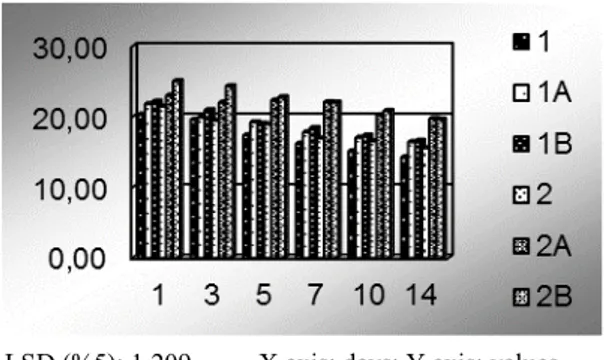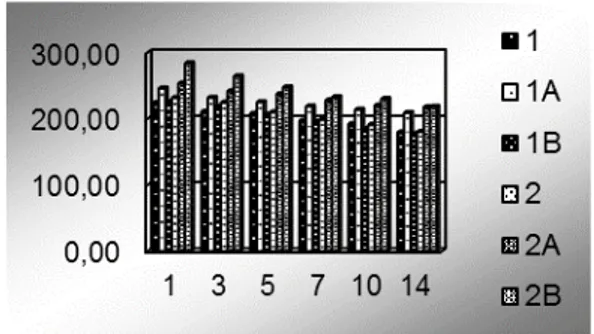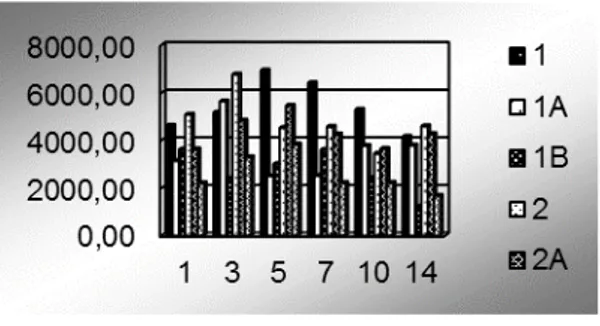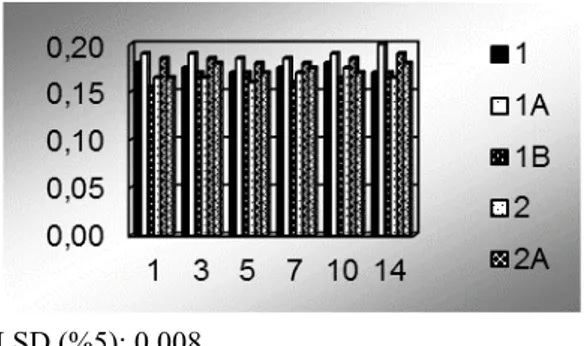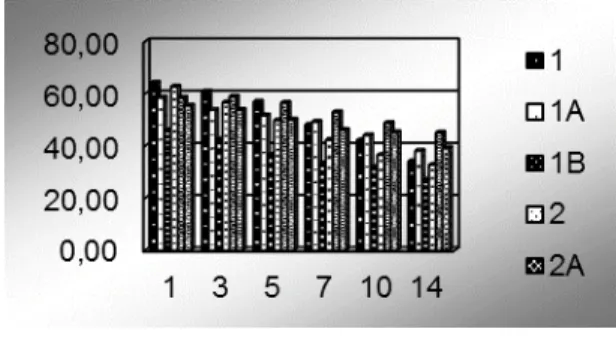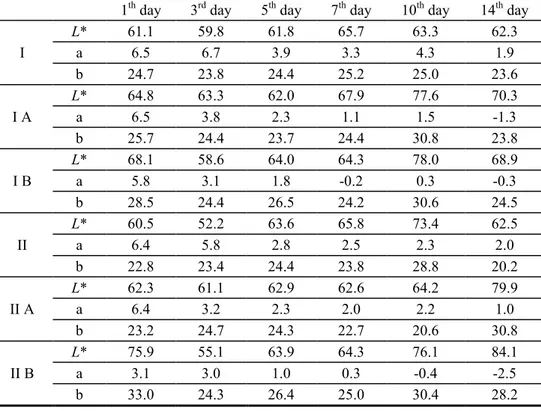U. Ü. ZİRAAT FAKÜLTESİ DERGİSİ, 2014, Cilt 28, Sayı 1, 29-42 (Journal of Agricultural Faculty of Uludag University)
Hurdle Technology for Shelf Stable Minimally
Processed Potato cv. Agria
aBige İNCEDAYI
1*, Canan Ece TAMER
1, Senem SUNA
1,
Ömer Utku ÇOPUR
11University of Uludag, Faculty of Agriculture, Department of Food Engineering. 16059, Bursa, Turkey
*e-mail: bige@uludag.edu.tr; Tel: + 90 224 294 15 04; Fax: + 90 224 294 14 02 Geliş Tarihi: 23.07.2014; Kabul Tarihi: 04.09.2014
Abstract: Chemical treatments in combination with modified atmosphere packaging and cold storage
was employed as hurdles for control of microorganisms and extending shelf life of minimally processed potatoes in this study. Washed and hand-peeled potatoes were treated with NaCl (1%) + Na-metabisulphite (1500 ppm), chlorinated (150 ppm, pH: 6.8, 5 min) and rinsed with water. They were divided into two lots and subjected to the following treatments: dip in solutions containing 1.5% citric acid and 0.5% L-cysteine + 1% citric acid. The samples were packaged at two different gas
combinations and stored at 4 to 6 ºC for 14 days. The weight loss of samples packaged under N2 was
lower than the samples packaged under N2 and CO2. Also L-cysteine was more effective than citric
acid for limiting weight loss by repressing metabolic activity. L-cysteine treatment with packaging under N2 and CO2 atmosphere had positive effects for protecting overall quality. Browning inhibited
up to two weeks with the help of chemical inhibitors. Rapid increase of total coliform bacteria count
after 8th day (especially in control samples) made inconsumable of these samples. However, citric
acid treatment prolonged the shelf life up to two weeks. As sensorial, L-cysteine treated samples were rejected in terms of odour, but preferred in terms of colour and appearence.
Key Words Potato, Minimal Processing, Enzymatic Browning, Polyphenol Oxidase Activity,
Antioxidant Activity, Total Phenolics.
Minimal İşlem Görmüş Agria Patates Çeşidi Üretiminde Raf
Ömrünü Arttıran Engeller Teknolojisi
Özet: Bu çalışmada mikrobiyal gelişimin kontrol altına alınması ve raf ömrünün uzatılması amacıyla,
Agria patates çeşidi minimal yöntemle işlenme aşamasında, engeller teknolojisi kapsamında, kimyasal muamele ile birlikte, modifiye atmosfer ortamında paketleme ve soğukta muhafazaya alınmıştır. Yıkanan ve kabukları soyulan patates yumruları, tuz (%1), sodyum metabisülfit (1500
ppm) ve klor (150 ppm, pH: 6.8, 5 dk) çözeltileri ile muamele edilmiş; durulandıktan sonra iki gruba ayrılarak; ilk grup %1.5 sitrik asit, diğer grup %1sitrik asit + %0.5 L-sistein çözeltisine daldırılmıştır.
İki farklı atmosfer koşuluna sahip ortamda paketlenen patatesler 4-6 ºC’de 14 gün muhafaza
edilmiştir. Ağırlık kaybı yalnızca azot ortamında paketlenen patateslerde daha düşük saptanırken; L-sistein metabolik aktiviteyi bastırararak ağırlık kaybını sınırlandırmıştır. Genel olarak L-L-sistein ve sitrik asit kombinasyonuyla muamele edildikten sonra, azot ve karbondioksit içeren ortamda paketlenen patateslerin kalitesi daha iyi korunmuştur. Ürünlerin esmerleşmesi iki haftaya kadar önlenebilmiş, ancak 8. günden sonra özellikle kontrol grubunda toplam koliform bakteri sayılarındaki artış nedeniyle, ürünler tüketilebilirliklerini kaybetmiştir. Buna rağmen, yalnızca sitrik asit uygulaması, ortalama iki hafta boyunca, ürünleri mikrobiyolojik yönden daha fazla güvence altına almıştır. Duyusal olarak ise L-sistein uygulaması yapılan patatesler koku yönünden red edilirken (p≤0.05), renk ve görünüş yönünden tercih edilmiştir.
Anahtar Kelimeler: Patates, Minimal Işleme, Enzimatik Esmerleşme, Polifenoloksidaz Aktivitesi,
Antioksidan Aktivite, Toplam Fenolik Madde.
Introduction
The market of minimally processed fruit and vegetables has increased in the last years as a response to the demand for quality and the modern way of life of consumers. The fundamental principle underlying the quality of these commodities is that they are metabolic active tissues and, as a consequence, show physiological response to preparation procedures as well as to the environment created in the package in which they are enclosed (Rocculi et al., 2009). The important quality attributes of fresh and minimally processed produce include appearance, colour, texture, flavour, nutritional value, and microbial safety (Lin and Zhao, 2007). To preserve quality and extend shelf life of fresh produce, some treatments such as antimicrobial agents, coatings, or edible films, modified atmosphere packaging (MAP) have been applied to fresh produce (Waimaleongora-Ek et al., 2008). MAP can decrease the rate of browning reactions due to reduced O2 level and elevated CO2
level in the surrounding atmosphere (Herner, 1987).
Hurdle technology involves the use of several preservation techniques in combination. This reduces the intensive use of one preservation technique producing a lower impact on the sensory quality (Ahn et al., 2005).
Potato (Solanum tuberosum L.), is the most important crop in the horticultural landscape of many countries (Jimenez et al., 2009). Minimal processing for fresh-cut potato production includes raw material selection, pre-washing and washing, sanitization, peeling and cutting, pre-treatments, draining, weighing and packaging (Rocculi, 2008). Fresh-cut preparation triggers many physiological and biochemical changes, such as increased respiration and ethylene production rates, induced synthesis of secondary metabolites, membrane disruption and activation of defence mechanisms (Brecht et al., 2004; Petri et al., 2008; Ma et al., 2010). The enzymatic browning of cut surfaces leads to loss of marketable quality and remains a major challenge for many minimally processed products (Toivonen and Brummell, 2008; Chiumarelli et al., 2011).
Microbiologically, these products are considered to be at the end of their shelf life when the total aerobic counts reach to 107-109 cfu g-1, the yeast counts reach to 105 cfu g-1or
combination with physical damage and physiological stress of minimal processing result in undesirable quality changes such as loss of firmness, off-odours and sliminess of the product. Therefore the utilization of packaging films with appropriate gas transmission rates and MAP in combination with low-temperature storage is the common hurdle approach for extending the shelf life of minimally processed fruits and vegetables (Al-Ati and Hotchkiss, 2002; McConnell et al., 2005).
This study was undertaken to determine the conditions required for extending the shelf life of minimally processed potatoes by applying MAP and cold storage. The chemical composition and the organoleptic properties of the potatoes during the storage were investigated in an attempt to determine the most effective treatment and the optimum processing parameters.
Materials and Methods
In this study, potatoes (Solanum tuberosum L.) cv. Agria obtained from the local plant of Bursa province was used 6 months after harvesting. The tubers were washed effectively, hand-peeled with sharp stainless steel knives and for inhibiting enzymatic oxidation, they were put into 1500 ppm Na-metabisulphite + 1 % NaCl solution. After washing with cold tap water, vegetables were dip-treated with 150 ppm Na-hypochloride (pH 6.8) for 5 minutes. They were then again washed with tap water to remove the dipping solution and the typical chlorine odour. The potatoes were divided into two lots and subjected to the following treatments: a 5 min dip in a solution containing 1.5% citric acid; a 10 min dip in a solution containing 0.5% L-cysteine + 1% citric acid. Centrifugation was used to remove of excess solution. They were then packed individually (approximately 250 g, 3 potato tubers) in polypropylene dishes (190 x 140 x 50 mm) with 42 µm BOPP (top film) packages. At 24 ºC, the O2 and the CO2 transmission rates of the film were 1775.40 cc m-2 day-1 and 6428.60
cc m-2 day-1 respectively. The packages were then separated into two groups. The first
group was sealed with an 80% vacuum with 80% N2;while the second group was sealed
with an 80% vacuum with 70% N2 + 10% CO2. The codes of the samples are;
I : samples packaged under N2 (control sample of the first group),
IA: samples packaged under N2 after the citric acid treatment,
IB: samples packaged under N2 after the L-cysteine + citric acid treatment,
II: samples packaged under N2 + CO2, (control sample of the second group),
II A: samples packaged under N2 + CO2 after the citric acid treatment,
II B: samples packaged under N2 + CO2 after the L-cysteine + citric acid treatment.
The ReeTray 25 TC model machine (Italy) was used for the packaging process. The seal temperature was set at 160 ºC and the seal time was 3 seconds. The minimally processed vegetables were stored at 4 to 6 ºC for 14 days.
Analyses
The amount of total dry matter was analyzed using the oven-dry method (AOAC 1990). The ascorbic acid was determined by direct spectrophotometrically using a 2,6-dichlorophenol indophenol dye (Cemeroğlu, 2007). The antioxidant activity was identified by using the 2,2-diphenylpicrylhydrazyl (DPPH) radical spectrophotometrically. The
inhibition percentage of the DPPH free radical at 517 nm was calculated (Zhang and Hamauzu, 2004). The method employed for the total phenolics was based on Folin-Ciocalteau’s phenol reagent (Spanos and Wrolstad, 1990). The spectrophotometric measurements for total phenolics were carried out at 452 nm using a Shimatzu UV 1800 model spectrophotometer and the results were calculated as the gallic acid equivalent (GAE). The total carotenoids were determined by using the spectrophotometric method (Kılıç et al., 1991). The polyphenol oxidase (PPO) activity was assayed spectrophotometrically by a modified method based on Galeazzi et al. (1981) and Tan and Harris (1995), and calculated as unit (U). 1 unit is equal to Δ0.001 absorbance/minute. The color of the samples (reflectance values) was measured using D 25APC2Δ model Hunterlab colorimeter and expressed as L, a* and b* values. Three replications were applied for the analysis of six samples.
The initial weight of the packaged samples was noted and periodical observations on the losses in weight were made by weighing the samples. So the results were expressed as a cumulative percentage loss. Microbiological analyses were done for total count of mesophilic aerobic bacteri and coliform bacteria (Maturin and Peeler, 2001; Blodget, 2006).
Sensory Evaluation
The modified atmosphere packaged vegetables were organoleptically evaluated for their quality attributes, such as colour, appearance, odour and texture, by a panel consisting of 8 members using a ranking test (Altuğ, 1993). According to this test, the panelists would order the samples from their best favorite one to their least favorite by giving a point between 1 and 6. As a result of this statistical test, the samples that ranked below 11 (the mean of all of the panelist’s point values) were preferred and samples ranked above 31 were rejected at the 95% probability level.
Statistical Analysis
The experiment was conducted in a completely randomized design with three replications. The results were statistically evaluated using a one way analysis of variance (ANOVA) in the JMP software package version 8.0 (SAS Institute Inc. NC, 27513). The means were compared using the LSD (Least Significant Difference) test (p<0.05).
Results and Discussions
The average width and the height of the potatoes were 6.37 and 7.71 cm. Hand peeling of potatoes resulted in 27.40% wastage and the fruit flesh/peel ratio was 2.65. The results of the analysis of the raw material are shown in Table 1.
Table 1. The results of some analysis of raw potato
Antioxidant activity (%) 34.38±2.65
Total phenolic matter (mg GAE 100g-1) 309.35±7.50
Ascorbic acid (mg 100g-1) 8.92±0.67
Polyphenol oxidase (PPO) activity (U g-1) 3199.36±5.38
Total dry matter (g 100g-1) 25.13±0.61
Total acidity* (g 100g-1) 0.18±0.00
Total carotenoids (mg kg-1) 65.70±1.63
L (brightness) 53.50±0.22
a (red - green) 5.90±0.03
b (yellow - blue) 20.80±0.14
Total bacteria count (cfu g-1) 1.9 x 102
Total coliform count (MPN g-1) < 3
* as citric acid
The difference between the antioxidant activity of minimally processed potatoes was statistically significant for application and storage period (p<0.01) and interaction of application x storage period (p<0.05). At the end of the 14th day, the reduction of the
antioxidant activity was 23.82%. The minumum loss of antioxidant activity was determined in sample II A which was treated with citric acid and packed under N2 and CO2 atmosphere
(Figure 1). Teow et al. (2007) reported that pale yellow potatoes contain lesser amount of phenolic compounds and having lower antioxidant activity than dark colored potatoes. Reyes et al. (2007) measured antioxidant activity of whole fresh potatoes as 682 μg TE mg -1 chlorogenic acid and this value decreased as 43% in sliced potatoes. Because of having
lesser amount of phenolic matter in pale yellow coloured Agria cultivar potato, its antioxidant activity was low (Tudela et al., 2002a).
LSD (%5): 1.209 X axis: days; Y axis: values
The difference between total phenolic matter content of minimally processed potatoes was statistically significant for application and storage period (p<0.01) and interaction of application x storage period (p<0.05). During the storage period, total phenolic matter reduced approximately as 19.22%. Citric acid treatment was effective for protecting the phenolic compounds. Especially this reduction was minumum in sample II A (Figure 2).
LSD (%5): 10.986
Figure 2. Total phenolic matter of samples (mg GAE 100 g-1)
Teow et al. (2007) determined total phenolic matter (as chlorogenic acid) of different potato cultivars as 0.14 to 0.51 mg g-1. Cutting and slicing resulted in 15% loss of phenolic
matter in short term (15 ºC for 2 days) storage of potato (Reyes et al., 2007).
The difference between ascorbic acid content of minimally processed potatoes was statistically significant (p<0.01). During three weeks of storage period, an important ascorbic acid loss (36.73%) occured. Citric acid reduced the pH of the environment and stabilized ascorbic acid and also due to this low pH, the activity of ascorbic acid oxidase might be slower down. For this reason, samples I A and II A had the highest ascorbic acid content (Figure 3).
LSD (%5): 0.406
Figure 3. Ascorbic acid content of samples (mg 100g-1)
Tudela et al. (2002b) reported that minimally processed potatoes could retain their initial vitamin C content after 6 days of air storage at 4 ºC. The low O2 permeability plastic
content of potato was 19.7 mg 100g-1 (Anonymous, 2014). McConnell et al. (2005)
determined this value between 14.7 and 15.4 mg 100g-1 in sweet potato. Şen and Batu
(2007) and Reyes et al. (2007) reported this value between as 7.04 to 9.6 mg 100g-1 and 5.0
mg 100g-1, respectively. The differences in the results might be originated from the
differences of variety, harvesting time, storage, MAP conditions, packaging type and solutions used.
The difference between the PPO activity of minimally processed potatoes was statistically significant for application, storage period and interaction of application x storage period (p<0.01). Generally PPO activity of samples I A, II and II A increased rapidly at the beginning of the storage period, then decreased at the midterm and again increased slightly at the end of storage. While PPO activity of samples I and II was higher than others, samples I B and II B which were treated with L-cysteine had the lowest PPO activity (Figure 4).
LSD (%5): 0.023
Figure 4. Polyphenol oxidase activity of samples (U g-1)
These samples were also preferred by the panellists for colour criteria, but control samples (I and II) were rejected in order to rapid browning (p<0.01). According to the results, L-cysteine was more effective for inhibiting PPO activity of potato. Yağar (2004) evaluated the PPO activity against different substrates and L-cysteine was determined as the most effective inhibitor. Sodium metabisulphite was also more effective than ascorbic acid, citric acid, sodium chloride and EDTA for inhibiting PPO of potato (Daungmal and Apenten, 1999; Molnar - Perl and Friedman, 1990). Except from control samples, treating with sodium metabisulphite (1500 ppm) of other samples helped inhibition of PPO. Güneş and Lee (1997) reported that L-cysteine (2%) and citric acid (0.5%) mixture had the highest inhibitory effect for minimally processed vegetables.
The reduction in total dry matter content was 1.19% during the storage period (p<0.01). Dry matter loss of control samples was higher than others. These samples were not treated with any solution slowing respiration and metabolic activity (Figure 5).
LSD (%5): 0.165
Figure 5. Total dry matter content of samples (g 100 g-1)
For this reason especially sugars were degraded with respiration and dry matter content might be reduced. Total dry matter content of potatoes was 20.66 g 100g-1 (Anonymous,
2014). Teow et al. (2007) and Çalışkan (2001) determined total dry matter between 24.9 and 34.9%, 18.58 and 22.02%; respectively. Although different cultivars were analysed, our results were in accordance with the results of the researchers.
The difference between total acidity of minimally processed potatoes was statistically significant for application, storage period and interaction of application x storage period (p<0.01). Samples I A and II A treated with citric acid had higher total acidity value (Figure 6). There were little changes in the total acidity values of the samples during the storage. Şen and Batu (2007) determined total acidity (as citric acid) of Marfona potato cultivar as 0.14 g 100g-1. Kader (1986) reported that due to diffusion of CO
2 to product, modified
atmosphere causes increase of acidity.
LSD (%5): 0.008
Figure 6. Total acidity of samples (g 100 g-1)
Mean loss of carotenoids during storage period was 37.15% (p<0.01). While the highest amount of carotenoids found in sample II A which was treated with citric acid and then packaged under N2 and CO2 atmosphere, the lowest amount of carotenoids was found
in sample I B which was treated with L-cysteine then packaged under N2 atmosphere. The
loss of carotenoids in control samples was about 50%. This could be explained by the preservative effect of solutions used in preparation of minimally processed potatoes (Figure
7). Ertürk and Picha (2007) determined total carotenoids of potatoes packed with low permeability packaging material as between 50.0 and 54.4 mg kg-1. McConnell et al. (2005)
reported total carotenoids of shredded and MAP potatoes as between 67 and 74 mg kg-1.
LSD (%5): 2.346
Figure 7. Total carotenoids of samples (mg kg-1)
L* (lightness) values of the control samples (I and II) were lower than the others. It
was related to browning of the surface of the samples due to the respiration and dehydration. a* value of these samples was the highest during three days then it was similar to other samples. The difference between the b* values of the samples was not significant. In some analysis period, samples I A, I B and II B showed the negative a* values. It might be depend on greenish surface of unhomogenous peeled samples (Table 2). Kaaber et al. (2002) measured L* value of potato as 76.6. Güneş and Lee (1997) determined this value as 65 at the beginning of storage. The mixture of 0.5% L-cysteine and 2% citric acid gave the best results on abrasion peeled and packaged potato slices in the same study. The control and the 0.5% L-cysteine dipping treatment resulted in significantly lower L* values than the other treatments. The cysteine-citric acid mixture, 5% ascorbic acid and 0.1% bisulfite had similar L* values, although cysteine-citric acid was the best visually. Therefore, this solution was as effective as bisulfite and chosen to be the best inhibitor solution. Cacace et al. (2002) reported that samples dipped in 5% erythorbic acid - 1% citric acid (99.9) had significantly higher L* values than strips dipped in 1% N-acetyl-L-cysteine (77) and 1% diethylenetriamine pentaacetic acid (48.3) after 21 days at 6 ºC. Şen and Batu (2007) measured L* value of potato packaged with 38 μm CPP film as 63.8 at 0th and 54.38 at 8th
days. a* and b* values were determined between -3.46 and 0.37; 19.39 and 25.02, respectively. Rocculi et al. (2007) determined L* and a* values of potato between 57 and 82; -1.4 and -6.5. The value of these parameters increased as the concentration of ascorbic acid and citric acid was changed from 0.5 to 2% in this study. In terms of a*, only L-cysteine treated samples maintained the levels around those of the fresh sample. The difference between the results might be originated from differences of pretreatments, cultivars, harvesting period and storage conditions.
Table 2. Color values (L, a*, b*) of minimally processed potato samples
1th day 3rd day 5th day 7th day 10th day 14th day
I L* 61.1 59.8 61.8 65.7 63.3 62.3 a 6.5 6.7 3.9 3.3 4.3 1.9 b 24.7 23.8 24.4 25.2 25.0 23.6 I A L* 64.8 63.3 62.0 67.9 77.6 70.3 a 6.5 3.8 2.3 1.1 1.5 -1.3 b 25.7 24.4 23.7 24.4 30.8 23.8 I B L* 68.1 58.6 64.0 64.3 78.0 68.9 a 5.8 3.1 1.8 -0.2 0.3 -0.3 b 28.5 24.4 26.5 24.2 30.6 24.5 II L* 60.5 52.2 63.6 65.8 73.4 62.5 a 6.4 5.8 2.8 2.5 2.3 2.0 b 22.8 23.4 24.4 23.8 28.8 20.2 II A L* 62.3 61.1 62.9 62.6 64.2 79.9 a 6.4 3.2 2.3 2.0 2.2 1.0 b 23.2 24.7 24.3 22.7 20.6 30.8 II B L* 75.9 55.1 63.9 64.3 76.1 84.1 a 3.1 3.0 1.0 0.3 -0.4 -2.5 b 33.0 24.3 26.4 25.0 30.4 28.2
At the first day of storage total bacteria count of control samples was higher than raw material. Total bacteria count of all other samples was lower than raw potato. It could be explained by microbial growth of chemically untreated potato and cross contamination. Dipping into chlorine solution was effective for limiting microbial growth. Except from control samples, coliform bacteria count of I A, I B, II A and II B was increased by 10th
day. CO2 contained environment had inhibitory effect on microorganisms to the end of the
storage and provided prolonged preservation. Especially, sensorial and microbiological quality of samples II A and II B could be protected during two weeks (Table 3). Products having total bacteria count more than 108 cfu g-1, could not be consumed because of their
negative characteristics such as physical damage, softening and off-odour.
Weight loss of MAP potato samples changed between 0.004 and 0.023% during storage. Especially any weight loss of sample I B and II B was related to the decrease of the respiration rate and metabolic activity (Table 4). Şen and Batu (2007) determined the weight loss of the MAP Marfona potato cultivar tubers lower than 4% after 8 months. However, this loss was higher than 12% in samples stored in air. Ertürk and Picha (2007) determined the maximum weight loss in mechanically peeled and packaged potato strips with different permeability films as 0.71%. Also low O2, CO2 and water vapour permeable
Table 3. The results of microbiological analysis of minimally processed potatoes
I I A I B II II A II B
1th
Day Total bacteria count (cfu g
-1) 1.5 x 104 2.5 x 101 3.7 x 102 1.9 x 103 <10 8 x 101
Total coliform count (MPN g-1) 240 <3 <3 23 <3 <3
3rd
Day Total bacteria count (cfu g
-1) 3.7 x 104 4 x 101 3.9 x 102 2.1 x 104 6.5 x 101 6.1 x 102
Total coliform count (MPN g-1) 4.6 x 102 <3 <3 <3 <3 <3
5th
Day Total bacteria count (cfu g
-1) 4.2 x 104 2.2 x 102 1.6 x 104 7.8 x 104 1.1 x 102 5.6 x 103
Total coliform count (MPN g-1) 1.1 x 103 < <3 6 <3 <3 <3
7th
Day Total bacteria count (cfu g
-1) 3.7 x 105 7.8 x 103 4.9 x 104 1.3 x 105 3.2 x 102 5 x 104
Total coliform count (MPN g-1) 4.6 x 102 <3 <3 1.1 x 103 < <3 <3
10th
Day Total bacteria count (cfu g
-1) 7.6 x 105 5.4 x 106 6.6 x 107 4.9 x 105 3 x 106 1.2 x 106
Total coliform count (MPN g-1) 1.1 x 103 < 460 <3 1.1 x 103 < 4.6 x 102 4.6 x 102
14th
Day Total bacteria count (cfu g
-1) 9.5 x 107 1.1 x 107 7.4 x 107 4.7 x 106 1.1 x 107 6.2 x 106
Total coliform count (MPN g-1) 1.1 x 103 < 11 1.1 x 103< 1.1 x 103 < <3 <3
Table 4. Weight loses of map minimally processed potato samples (%)
0th day 1th day 3rd day 5th day 7th day 10th day 14th day Weight loses during storage
period (%) I 281.18 281.26 281.23 281.21 281.23 281.13 281.14 0.014 I A 262.57 262.65 262.62 262.62 262.63 262.61 262.56 0.004 I B 263.32 263.43 263.37 263.37 263.36 263.36 263.35 - II 213.75 213.83 213.79 213.79 213.77 213.72 213.70 0.023 II A 259.22 259.27 259.25 259.25 259.28 259.18 259.16 0.023 II B 272.10 272.09 272.10 272.14 272.16 272.11 272.10 -
According to sensory analysis results, control samples were generally disapproved. The most preferred samples were L-cysteine treated potatoes (I B and II B). L-cysteine treated tubers protected their colour stability in general. These samples also had higher L* values. Same samples were rejected by panellists in some storage periods according to odour criteria. As a sulfite containing compound, L-cysteine caused off-odour in these samples (I B and II B). By the 14th day of storage, with increasing microbial population and starting
decomposition, sample I was rejected because of its off-odour and the difference between the other samples was not distinctive. In this term, only sample treated with citric acid and packaged in N2 and CO2 environment (II A) was preferred (p<0.05). Samples were
evaluated according to the luminosity, crusting and bulge formation of the package for appearance criteria. Control samples (I and II) showed browning and crusting rapidly and bulge was formed in their packages. For this reason, these samples were rejected during the storage period. Their L* values were also lower than the others (p<0.05). According to the appearance criteria, samples I B and II B which had higher L* values preferred by panellists (p<0.05). Also weight loss of these samples was limited, microbial growth was slow and bulge formation in the packages was not occured. No statistically significant difference was found between samples treated with citric acid (I A and II A) in terms of appearance. The difference between the hardness of minimally processed potatoes was found
non-significant. Sample I was rejected at the 10th and 14th days of storage. Microbial activity
increased and also textural problems like softening occured at the end of the storage period.
Conclusions
During the storage period, ascorbic acid, total phenolic matter and carotenoid content of minimally processed potatoes were reduced. This reduction was the highest in the control samples. The browning could be inhibited up to two weeks with the help of chemical inhibitors. Because of the metabolic activity continued, weight loss occured during storage. L-cysteine was more effective than citric acid for limiting weight loss by repressing physiological activity. For this reason, L-cysteine treatment had positive effects for protecting quality. But, in order to sulfite containing form of L-cysteine, off-odour was feeled, therefore its concentration should be optimized for sensorial quality. Although these samples preferred by panellists for colour and appearance (p<0.05). Total bacteria and coliform bacteria counts were increased rapidly after 10th day, these products could not be
consumed. However, N2 and CO2 environment prolonged the shelf life up to two weeks.
Acknowledgements
The authors would like to thank to TÜBİTAK (The Scientific and Technological Research Council of Turkey) for the financial support (Project No: 107 O 664).
References
Ahn, H.J., Kim, J.H., Kim, J.K., Kim, D.H., Yook, H.S. and M.W., Byun, 2005. Combined effects of irradiation and modified atmosphere packaging on minimally processed Chinese cabbage (Brassica rapa L.). Food Chemistry, 89 (4). 589–597.
Al-Ati, T. and J.H., Hotchkiss, 2002. Application of packaging modified atmosphere the fresh-cut fruits and vegetables. In: Fresh-cut fruits and vegetables, science, technology and market. New York: CRC Press.
Altuğ, T. 1993. Duyusal Test Teknikleri. E.Ü. Müh. Fak. Ders Kitapları Yayın No: 28, İzmir.
Anonymous. 2014. USDA National Nutrient Database for Standard Reference. Release 26. http://ndb.nal.usda.gov/ndb/foods/show/3137?fg=&man=&lfacet=&format=&count=&max=25 &offset=&sort=&qlookup=potato
AOAC. 1990. Official Methods of Analysis of the Association of Official Analytical Chemists, Vol. II, (Ed) S. Williams, Arlington, D.C. Washington, edn. 15.
Blodget, R.J. 2006. Most Probable Number from Serial Dilutions. FDA Bacteriological Analytical
Manual Online, February 2006. Appendix 2. BAM 8th Edition.
http://www.fda.gov/Food/FoodScienceResearch/LaboratoryMethods/ucm109656.htm
Brecht, J.K., Saltveit, M.E., Talcott, S.T., Schneider, K.R., Felkey, K. and J.A., Bartz, 2004. Fresh-cut vegetables and fruits. Horticultural Reviews, 30. 185-251.
Cacace, J.E., Delaquis, P.J. and G., Mazza, 2002. Effect of chemical inhibitors and storage temperature on the quality of fresh-cut potatoes. Journal of Food Quality, 25. 181-195.
Chiumarelli, M., Ferrari, C., Sarantopoulos, C. and M. Hubinger, 2011. Fresh cut ‘Tommy Atkins’ mango pre-treated with citric acid and coated with cassava (Manihot esculenta Crantz) starch or sodium alginate. Innovative Food Science and Emerging Technologies,12. 381–387.
Curlee, J. 1997. Preserving produce. Journal of Food Quality, 20. 24-30.
Çalışkan, M.E. 2001. Farklı olgunlaşma grubuna giren bazı patates çeşitlerinin Hatay ekolojik koşullarındaki verim ve kalite özelliklerinin belirlenmesi. MKU Ziraat Fakültesi Dergisi, 6. 39-50.
Daungmal, K., and R.K.O., Apenten, 1999. A comparative study of polyphenoloxidases from taro (Colocasia esculenta) and potato (Solanum tuberosum var. Romano). Food Chemistry, 64. 351-359.
Ertürk, E. and D.H., Picha, 2007. Effect of temperature and packaging film on nutritional quality of fresh-cut sweet potatoes. Journal of Food Quality, 30. 450-465.
Galeazzi, M.A.M., Sgarbieri, V.C. and S.M., Constantinides, 1981. Isolation, purification and physicochemical characterization of poliphenol oxidases (PPO) from dwarf variety of banana (Musa cavendishii, L). Journal of Food Science, 46.150-155.
Güneş, E. and C., Lee, 1997. Color of minimally processed potatoes as affected by modified atmosphere packaging and antibrowning agents. Journal of Food Science. 62(3). 572-575. Herner, R.C. 1987. High CO2 effects on plant organs. In Postharvest physiology of vegetables, (J.
Weichmann, ed.), pp. 239-254. Mercel Dekker, Inc., New York and Basel.
Jimenez, M.E., Rossi, A.M. and N.C., Saman, 2009. Phenotypic, agronomic and nutritional characteristics of seven varieties of Andean potatoes. Journal of Food Composition and Analysis, 22. 613-616.
Kaaber, L., Martinsen, B.K., Brathen, E. and I., Shomer, 2002. Browning inhibition and textural changes of pre-peeled potatoes caused by anaerobic conditions. Lebensmittel-Wissenschaft und-Technologie, 35. 526-531.
Kader, A.A. 1986. Biochemical and physiological basis for effects of controlled and modified atmospheres on fruits and vegetables. Food Technology, 40. 99-104.
Kılıç, O., Çopur, Ö.U. and Ş., Görtay, 1991. Meyve ve Sebze İşleme Teknolojisi Uygulama Kılavuzu. Uludağ Üniversitesi Ziraat Fakültesi Ders Notları: 7, Bursa.
Lin, D. and Y., Zhao, 2007. Innovations in the development and application of edible coatings for fresh and minimally processed fruits and vegetables. Comprehensive Reviews in Food Science and Food Safety, 6(3). 60-75.
Ma, Y., Wang, Q., Hong, G. and M., Cantwell, 2010. Reassessment of treatments to retard browning of fresh-cut Russet potato with emphasis on controlled atmospheres and low concentrations of bisulphite. International Journal of Food Science and Technology, 45. 1486-1494.
Maturin, L. and J.T., Peeler, 2001. Aerobic Plate Count. FDA Bacteriological Analytical Manual Online, January 2001. Chapter 3. BAM 8th Edition.
http://www.fda.gov/Food/FoodScienceResearch/LaboratoryMethods/ucm063346.htm
McConnell, R.Y., Truong, V.D., Walter, W.M. and R.F., McFeeters, 2005. Physical, chemical and microbial changes in shredded sweet potatoes. Journal of Food Processing and Preservation, 29. 246-267.
Molnar-Perl, I. and M., Friedman, 1990. Inhibition of browning by sulfur amino acids. 3. Apples and potatoes. Journal of Agricultural and Food Chemistry, 38. 1652-1656.
Petri, E., Arroqui, C., Ango´ s, I and P., Vi´rseda, 2008. Effect of preservative agents on the respiration rate of minimally processed potato (Solanum tuberosum cv. Monalisa). Journal of Food Science and Technology, 73(3). 122-126.
Reyes, L.F., Villarreal, J.E. and L., Cisneros-Zevallos, 2007. The increase in antioxidant capacity after wounding depends on the type of fruit or vegetable tissue. Food Chemistry, 101. 1254-1262.
Rocculi, P., Galindo, F.G., Mendozac, F., Wadsö, L., Romani, S., Rosa, M.D. and I., Sjöholm, 2007. Effects of the application of anti-browning substances on the metabolic activity and sugar composition of fresh-cut potatoes. Postharvest Biology and Technology, 43. 151-157.
Rocculi, P. 2008. Key factors for fresh-cut potatoes quality and stability. Proceedings of the 52nd
Italian Society of Agricultural Genetics Annual Congress Padova, Italy – 14/17 September, 2008.
Rocculi, P., Romani, S., Gómez, F. and M.D., Rosa, 2009. Effect of minimal processing on physiology and quality of fresh-cut potatoes: A review. Food, 3:18-30
Spanos, G.A. and R.E., Wrolstad, 1990. Influence of processing and storage on the phenolic composition of Thompson seedless grape juice. Journal of Agricultural and Food Chemistry, 38(3). 817-824.
Şen, L. and A., Batu, 2007. Patatesin modifiye atmosferde paketlenerek depolanması. Gıda Teknolojileri Elektronik Dergisi, 1. 7-15.
(http://www.teknolojikarastirmalar.com/pdf/tr/02_020107_2_sen_tr.pdf)
Tan, B.K. and N.D., Harris, 1995. Maillard products inhibit apple polyphenoxidase. Food Chemistry, 53. 267-273.
Teow, C.C., Truong, V., McFeeters, R.F., Thompson, R.L., Pecota, K.V. and G.C., Yencho, 2007. Antioxidant activities, phenolic and β-carotene contents of sweet potato genotypes with varying flesh colours. Food Chemistry, 103. 829-838.
Toivonen, P.M.A. and D.A., Brummell, 2008. Biochemical bases of appearance and texture changes in fresh-cut fruit and vegetables. Postharvest Biology and Technology, 48. 1-14.
Tudela, J.A., Cantos, E. J., Espin, C., Tomas-Barberan, F.A. and M.I., Gil, 2002a. Induction of antioxidant flavonol biosynthesis in fresh-cut potatoes. Effect of domestic cooking. Journal of Agricultural and Food Chemistry, 50. 592-593.
Tudela, J.A., Espin, J.C. and M.I., Gil, 2002b. Vitamin C retention in fresh-cut potatoes. Postharvest Biology and Technology, 26. 75-84.
Waimaleongora-Ek, P., Corredor, A.J.H., No, H.K., Prinyawiwatkul, W.J., King, M., Janes, M.E. and S., Sathivel, 2008. Selected quality characteristics of fresh-cut sweet potatoes coated with chitosan during 17-day refrigerated storage. Journal of Food Science and Technology, 73(8). 418-423.
Yağar, H. 2004. Some biochemical properties of polyphenol oxidase from celery. Preparative Biochemistry and Biotechnology, 34(4). 387-397.
Zhang, D. and Y., Hamauzu, 2004. Phenolics, ascorbic acid, carotenoids and antioxidant activity of broccoli and their changes during conventional and microwave cooking. Food Chemistry, 88. 503-509.
